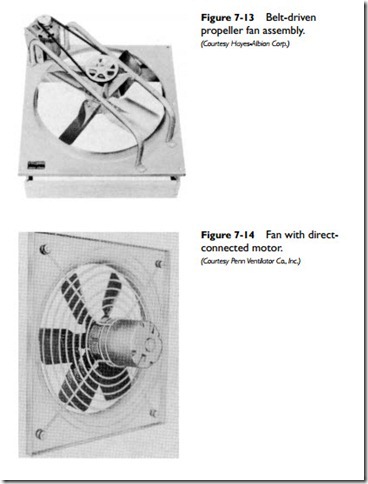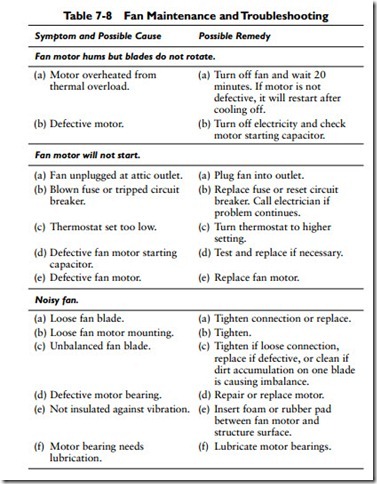Troubleshooting Fans
Fan motors are electrically powered (see Table 7-8). Always turn off the electricity before attempting to service or repair a fan. Failure to do so could result in serious injury or even death because high voltages are involved. Electrical tests on fan motors should be done by a qualified electrician.
Fan motors mounted in the airstream are cooled by a portion of the air drawn around them. This acts to hold motor temperatures
down and makes it possible for the motor to run continuously at substantial brake horsepower (bhp) overloads without exceeding its rated temperature rise.
The actual brake horsepower load has little relation to its name- plate horsepower as long as it remains at or below its rated maximum
temperatures. It is temperature rise that is crucial to the breakdown or burning out of a fan motor (even though it may be physically underloaded).
A fan motor will normally run at a temperature too hot to hold a hand against it, but this will still be at or below the manufacturer’s temperature rise limit as stated on the nameplate. When a fan motor
does overheat or burn out, it is usually for one of the following reasons:
1. Defective motor.
2. Line voltage too high or too low for the rated motor voltage (more than plus or minus 10 percent voltage deviation is considered excessive).
3. The belts on belt-driven fans may be too tight or too loose, causing slippage and consequent loss of the cooling effect of air passing around the motor.
4. Improper pulleys on belt-driven fans will result in too high a fan rpm, which causes overloading.
5. Backward- and forward-curved wheel centrifugal fans or roof ventilators running backward will guarantee an overload condition. Remember that all centrifugal fans blow in one direction only, regardless of rotation; propeller fans that run backward blow backward.
6. Propeller fans may be starved for air as a result of insufficient intake (or outlet) area. The fans are literally starved for air, which causes the static pressure to rise and the brake horsepower load on the motor to increase. The air that flows around the motor is also reduced, causing the motor to overheat. Attic fans are frequently damaged as a result of inadequate outlet area.


